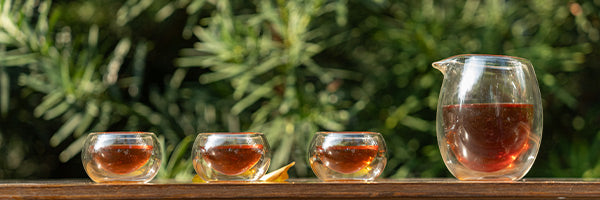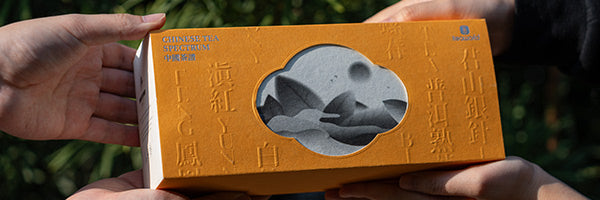Независимо от того, новичок ли вы в чае или опытный любитель чая, изучение обширного мира черного и зеленого чая может стать приятным приключением. Хотя оба производятся из листьев Camellia sinensis, их обработка сильно отличается, что приводит к уникальным вкусам, ароматам и полезным свойствам. В этом руководстве мы сравним листовой черный чай и зеленый чай , от дарджилинга до сенчи, и дадим советы по завариванию, чтобы раскрыть лучшее в каждом сорте. Вы готовы открыть для себя сложные вкусы этих любимых чаев? Тогда пусть ваше путешествие за чашкой чая начнется!

Что такое листовой чай?
Прежде чем углубляться в черный и зеленый чай, важно понять, что представляет собой листовой чай. В отличие от чайных пакетиков, которые содержат сломанные чайные листья и фаннинги, листовой чай состоит из цельных, нетронутых чайных листьев. В iTeaworld все их черные и зеленые чаи доступны в высококачественной листовой форме для более насыщенного чаепития.
Листовой чай сохраняет полный вкус и аромат листьев лучше, чем сломанные кусочки. Во время заваривания целые листья способны полностью раскрыться и высвободить свои сложные вкусы и аромат. Это также позволяет легче контролировать время заваривания в соответствии с индивидуальными вкусами. Листовой чай обычно обеспечивает более насыщенную чашку и предпочтителен для взыскательных любителей чая, заинтересованных в изучении различных типов и происхождений.
Обработка: главное различие между черным и зеленым чаем
Ключевое различие между черным и зеленым чаем заключается в методах обработки после сбора урожая. Для зеленого чая листья быстро нагревают, пропаривают, обжаривают на сковороде или разминают, чтобы предотвратить ферментативное окисление. Это останавливает процесс потемнения, оставляя листья зелеными и сохраняя их первоначальные вкусовые характеристики.
Напротив, листья черного чая подвергаются процессам, называемым «ферментацией» после сбора. Листьям позволяют окисляться или подвергаться ферментативным реакциям потемнения, запускаемым природными ферментами растения полифенолоксидазой в течение определенного периода. Это приводит к тому, что листья темнеют до красновато-коричневого или черного цвета.
Процесс ферментации черного чая влияет на его химический состав и вкус по сравнению с зеленым чаем. Он разрушает пигменты хлорофилла, что приводит к отличительному цвету напитка. Ферментация также изменяет исходные флаванолы зеленого чая на другие типы, которые, как считается, обладают полезными для здоровья свойствами, такие как теафлавины и теарубигины, уникальные для черного чая. Эта обработка является причиной того, что черный и зеленый чай сильно различаются по характеристикам, несмотря на использование одного и того же сырья.
Различия во внешнем виде, цвете и запахе
Визуально черный чай имеет красновато-коричневый или темно-коричневый цвет по сравнению с желтовато-зеленым оттенком зеленого чая. При заваривании черного чая в горячей воде он приобретает яркий золотисто-коричневый или красный оттенок. В отличие от этого, зеленый чай заваривается до нежного бледно-желто-зеленого оттенка.
Различные методы обработки также способствуют изменению аромата. Черный чай имеет сладкий, солодовый, табачный аромат, тогда как листья зеленого чая источают более травянистый, растительный аромат с нотками вареного шпината или водорослей. Их вкусовые профили напрямую соответствуют этим запахам и отчетливо либо солодово-жирные, либо чистые и растительно-травянистые.
Содержание кофеина и питательных веществ
Естественно, листовой зеленый чай и черный чай содержат кофеин из растения Camellia sinensis. Однако листовой черный чай имеет немного более высокое среднее количество кофеина на чашку — около 47 мг по сравнению с листовым зеленым чаем — 29 мг. Точное количество варьируется в зависимости от времени заваривания и сорта листьев.
Помимо кофеина, зеленый чай славится высокой концентрацией мощных антиоксидантов, называемых катехинами. Его главный катехин, EGCG, составляет около 50-80% от общего содержания катехинов. Между тем, процесс ферментации черного чая преобразует некоторые катехины в теафлавины и теарубигины, поэтому в нем меньше катехинов, чем в зеленом, но больше этих уникальных соединений.
Черный и зеленый чай также содержат небольшое количество минералов, таких как магний, марганец и фторид. Оба могут быть частью сбалансированной диеты и могут способствовать антиоксидантным свойствам.

Польза для здоровья листового черного чая по сравнению с зеленым чаем
Благодаря своим уникальным полифенольным профилям, как черный, так и зеленый чай обладают различными полезными свойствами. Вот их разбивка:
- Здоровье сердечно-сосудистой системы: Исследования показывают, что катехины зеленого и черного чая могут улучшить здоровье сердечно-сосудистой системы, снижая уровень холестерина ЛПНП и артериальное давление. Теафлавины черного чая также могут помочь.
- Профилактика рака: полифенолы в черном и зеленом чае обладают антиоксидантными и противовоспалительными свойствами, которые могут помочь снизить риск развития рака.
- Здоровье мозга: катехины проникают через гематоэнцефалический барьер и продемонстрировали в клинических испытаниях пользу для когнитивных функций, таких как память и концентрация внимания.
- Здоровье полости рта: фториды и полифенолы, содержащиеся в листовом чае, могут уменьшить количество бактерий и уровень зубного налета вокруг зубов и десен.
- Здоровье кожи: антиоксиданты борются со свободными радикалами и способствуют выработке коллагена, благодаря чему кожа выглядит более чистой и молодой.
- Контроль веса: катехины могут умеренно усиливать термогенез и окисление жиров, способствуя контролю веса.
- Лечение диабета: антиоксиданты помогают регулировать чувствительность к инсулину и метаболизм глюкозы.
Однако есть некоторые различия в их воздействии:
Зеленый чай имеет более надежную репутацию в профилактике рака благодаря своей уникальной способности EGCG вызывать апоптоз или запрограммированную гибель раковых клеток.
Исследования показывают, что черный чай более полезен при сердечных заболеваниях и контроле уровня холестерина, чем зеленый чай, благодаря содержащимся в нем теафлавинам.
Для здоровья полости рта и кожи зеленый чай, содержащий большое количество антиоксиданта EGCG, обеспечивает лучшую защиту от ультрафиолетового излучения, чем черный чай.
В целом, как черный, так и зеленый листовой чай обладают значительными преимуществами. Однако исследования показывают, что содержание катехина в зеленом чае может сделать его немного более полезным вариантом в балансе. Умеренное употребление — ключ к получению их преимуществ. 
Вкусы и ароматы черного и зеленого листового чая
Что касается вкуса, ферментированные черные чаи предлагают более смелый, более насыщенный вкусовой профиль по сравнению с более легкими, травянистыми тонами зеленых чаев. Давайте рассмотрим некоторые конкретные сорта:
Черный чай:
Черный чай Юньнань: Ореховые ароматы со сладостью патоки и землистыми оттенками. Очень крепкий и солодовый вкус.
Черный чай Ассам: солодовый с нотками карамели и пряными нотками, такими как корица. Яркий и бодрящий.
Черный чай Дарджилинг: начальный фруктовый оттенок, напоминающий мускатный виноград, с четким послевкусием.
Лапсанг Сушонг: Необычный дымный вкусовой профиль, напоминающий о костре. Отличается от черных чаев.
Зеленый чай:
Зеленый чай Сенча: травянистый аромат и вкус в сочетании с легкой горчинкой и сладким послевкусием.
Зеленый чай матча: насыщенный вкус умами за счет измельченных листьев и шелковистая, кремовая консистенция.
Зеленый чай Генмайча: аромат поджаренного зерна, получаемый при добавлении в настой коричневого риса, сочетается с растительными нотками зеленого чая.
Зеленый чай с жасмином: нежный цветочный аромат цветков жасмина, наложенный на растительную основу чая.
В то время как черный чай предлагает более весомые солодовые, ореховые и пряные ноты, качественный зеленый чай демонстрирует более тонкие травянистые, цветочные и растительные ноты в зависимости от сорта. В конечном итоге выбор сводится к уникальным предпочтениям в отношении глубины или тонкости вкуса. Оба, безусловно, заслуживают изучения для оценки сложных вкусовых профилей чая.

Лучшие листовые черные и зеленые чаи
Чтобы помочь вам изучить и сравнить лучшие сорта, вот некоторые из наиболее рекомендуемых iTeaworld сортов рассыпного черного и зеленого чая:
Лучшие листовые черные чаи
Черный чай Юньнань: Выращенный на большой высоте, этот насыщенный черный чай имеет интенсивную солодовую сладость с нотками меда и карамели. Это отличный ежедневный напиток, полный вкуса, но не слишком стимулирующий.
Дикий черный чай Сушонг: выращиваемый рядом с соснами, этот уникальный черный чай имеет дымные угольные оттенки, которые напоминают о кострах, а также его яркий, бодрый финиш. Сушонг — смелый и отличительный сорт.
Yingde Black Tea: Этот мягкий черный чай, произведенный вблизи древних чайных деревьев, которым сотни лет, имеет сложные вкусы с фруктовыми оттенками, такими как сливы или ягоды. Многовековые деревья придают глубину и сложность.
Лучшие листовые зеленые чаи
Японский зеленый чай Сенча: маслянистый и слегка сладкий, этот сорт средней заварки, выращенный вдоль побережья Японии, имеет приятные растительные вкусы. Он делает доступное знакомство с зеленым чаем.
Зеленый чай Лунцзин: Считается лучшим в Китае, этот ароматный зеленый чай имеет нежный цветочный аромат и сладкое послевкусие, которое сохраняется. Выращенный около Западного озера, минералы в почве придают ему оттенки умами.
Зеленый чай Генмайча: поджаренный рис, смешанный с пропаренными листьями зеленого чая, придает этому крепкому сорту ореховые нотки, дополняющие его растительную основу. Насыщенный вкус, но не горький.
Зеленый чай с жасмином: нежные цветы жасмина наслаиваются на пропаренный чай для получения ароматного настоя. Свежий и цветочный, он станет прекрасным вечерним напитком.
Заваривание и настаивание черного и зеленого чая
Поскольку листья черного и зеленого чая различаются, оптимальные способы их заваривания немного различаются:
Черный чай:
Листовой черный чай обеспечивает крепкий, насыщенный напиток при правильном приготовлении. В отличие от пакетированного чая, листовой чай обеспечивает полное насыщение вкуса. Чтобы получить максимум от черного чая, доведите свежую воду до кипения, а затем снимите с огня. Идеальная температура воды для заваривания черного чая составляет 98 °C. На каждые 6 унций почти кипящей воды используйте 1-2 чайные ложки листового чая. Заваривайте в течение 3-5 минут, чтобы извлечь глубокие ароматы, такие как карамель, орехи и специи, не извлекая чрезмерно горькие танины. Дайте чаю время полностью раскрыть свой аромат и вкус. Листовой черный чай можно осторожно заваривать 2-3 раза, используя те же листья, чтобы максимально использовать каждый чайник. Правильное заваривание раскрывает восхитительную глубину черного чая.
Зеленый чай:
Правильное заваривание листового зеленого чая позволяет полностью раскрыться его тонким ароматам. В отличие от черного чая, зеленый чай лучше всего заваривать при более низкой температуре, чтобы избежать горечи. Доведите воду до слабого кипения, затем дайте ей остыть до 79-85 °C, прежде чем заливать чайные листья. На каждые 6 унций воды используйте 1-2 чайные ложки листового зеленого чая . Заваривайте всего 1-3 минуты, так как зеленый чай быстро настаивается и может стать горьким, если его передержать. Аккуратно помешивайте листья во время заваривания, чтобы полностью извлечь аромат, не ломая их. Зеленым чаем лучше всего наслаждаться за один короткий завар. Следуя этим рекомендациям, вы сможете насладиться сладкими растительными ароматами в каждой чашке.
Выбор в пользу здоровья
1. Чай, способствующий контролю уровня холестерина:
Полифенолы черного чая и чая улун, такие как теафлавины, помогают снизить уровень холестерина ЛПНП, уменьшая риск сердечных заболеваний, согласно исследованиям. Однако процесс ферментации немного снижает содержание катехинов в черном чае по сравнению с зеленым чаем.
2. Профилактика рака:
Благодаря высокому содержанию антиоксидантов зеленые чаи продемонстрировали потенциальные защитные эффекты против некоторых видов рака в некоторых исследованиях. Такие соединения, как EGCG, в изобилии встречающиеся в зеленом чае, могут нейтрализовать канцерогены или подавлять рост опухолей. Дополнительные исследования все еще ведутся.
3. Управление весом:
Считается, что катехины в зеленом чае стимулируют окисление жиров и термогенез, помогая сжигать калории с течением времени. Он также может уменьшить тягу к сладкому в сочетании со здоровой диетой. Черный чай содержит кофеин, который также обеспечивает легкий метаболический импульс.
4. Контроль диабета:
Некоторые исследования связывают активацию сигнала инсулина соединением зеленого чая с лучшей регуляцией сахара в крови, что обещает лечение диабета. Однако клинические эффекты все еще считаются скромными, и необходимы дополнительные исследования.
5. Здоровье зубов:
Содержание фтора и полифенолов во всех сортах чая помогает укрепить целостность зубной эмали и уменьшить образование зубного налета, защищая от гингивита и кариеса в долгосрочной перспективе.
В целом, черный и зеленый чай предлагают различные, но в целом полезные питательные профили. Их антиоксидантные и другие полезные для здоровья соединения обеспечивают индивидуальные варианты в зависимости от индивидуальных приоритетов в области здоровья и диетических предпочтений, которые можно изучить с помощью лучших сортов листового чая.
Выбор лучшего листового чая для вас
Когда дело доходит до выбора лучшего для вас листового чая, в конечном итоге все сводится к личным предпочтениям. Как черный, так и зеленый чай предлагают широкий спектр вкусов и полезных для здоровья свойств, поэтому важно попробовать разные сорта и найти тот, который подходит вашим вкусовым рецепторам и образу жизни. В iTeaworld мы предлагаем Tea Sampler , который включает в себя различные виды черного и зеленого чая, чтобы вы могли попробовать и найти свои любимые. Наш выбор чая также включает в себя ряд черного и зеленого чая, что позволяет вам исследовать различные вкусы и ароматы.
Черный пятничный чай: идеальное время запастись любимым чаем
iTeaworld с радостью предлагает нашим клиентам потрясающие предложения во время нашей ранней распродажи чая в черную пятницу. Это идеальное время, чтобы запастись любимым чаем или начать праздничный шопинг. Наше предложение «Лучший подарок» включает в себя пробник чая, который станет идеальным подарком для любого любителя чая. Просто купите любой из наших специальных продуктов и получите еще один набор чая бесплатно по коду BF50. А для всех любителей чая предоставляется скидка 20% на все чаи по коду BF20. Не упустите эти потрясающие предложения, чтобы распространить тепло черного чая в этот праздничный сезон. Приятного чаепития!
В заключение, черный и зеленый чай могут быть получены из одного и того же растения, но они предлагают разные вкусы и преимущества для здоровья . Предпочитаете ли вы смелый и крепкий вкус черного чая или нежный и освежающий вкус зеленого чая, iTeaworld предлагает вам широкий выбор листового чая на выбор. Воспользуйтесь нашей распродажей в Черную пятницу и запаситесь любимым чаем сегодня. Приятного чаепития!













































































